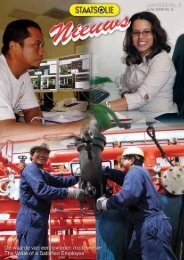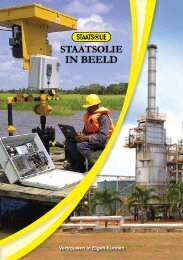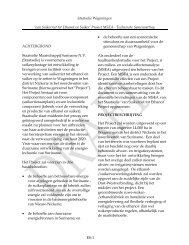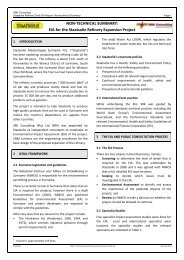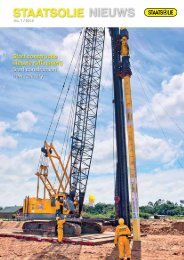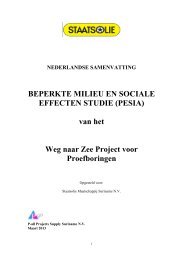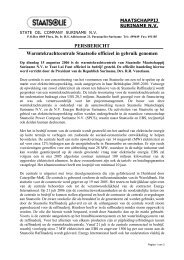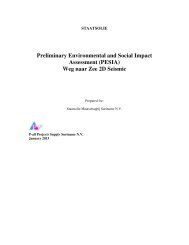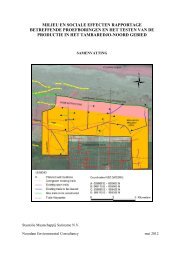concept EIA-rapport - Staatsolie
concept EIA-rapport - Staatsolie
concept EIA-rapport - Staatsolie
You also want an ePaper? Increase the reach of your titles
YUMPU automatically turns print PDFs into web optimized ePapers that Google loves.
SRK Consulting: Project No: 439414 <strong>Staatsolie</strong> Pipeline <strong>EIA</strong> – Draft <strong>EIA</strong> Report Page 64<br />
Any potential impacts of the project on climate change or vice versa are considered insignificant, as:<br />
• The pipeline is located mostly underneath the Suriname River, and rises in its level will therefore<br />
not affect the pipeline;<br />
• Drill pads on the riverbank are only used during the construction period; and<br />
• The conveying of the product in the pipelines will not result in the release of significant amounts<br />
of greenhouse gases.<br />
6.3 Potential impact: Surface water pollution due to construction<br />
activities<br />
Potential impacts of routine activities during the pipeline construction phase on surface water quality<br />
may result from:<br />
• Disposal of surplus drilling mud into the Suriname River (see Section 6.7.1 for potential impacts<br />
of accidental releases of drilling mud); and<br />
• Runoff of sediments or contaminated water from construction activities.<br />
Disposal of remaining drilling mud into the Suriname River<br />
Some 360 tons of water based drilling mud, equating to 18 tons of bentonite, will remain in the mud<br />
pits at the end of drilling and need to be disposed of. One option for disposal is the release of this<br />
surplus mud into the Suriname River 32 . It is assumed that each of the four drill sections will generate<br />
a fraction of the overall surplus mud, so that a smaller quantity of drilling mud needs to be<br />
discharged every time a HDD section has been completed.<br />
Bentonite is non-toxic, and based on the preliminary list of likely and possible ingredients of the<br />
drilling mud, it is not expected that the mud will contain trace metals, which can have toxic effects on<br />
aquatic organisms (Visser & Smit Hanab, 2011). Bentonite mud is listed on the PLONOR 33 list.<br />
However, it could result in increased silt content in the vicinity of the release point and benthic<br />
invertebrates, aquatic plants and fish and their eggs can be smothered by the fine bentonite particles<br />
(Sacramento Municipal Utility District, 2001).<br />
In a separate, unrelated study of marine, dispersion modelling for the discharge of 500 tons of drilling<br />
mud and 500 tons of drill cuttings into the marine environment approximately 5 m above the sea bed<br />
indicated a radial pattern of deposition. The modelled thickness of bottom deposition is highest at the<br />
discharge source and does not exceed 10 mm at a distance of 50 m from the source. A conservative<br />
estimate of the depth of instantaneous smothering that the major organism classes within the<br />
benthos communities inhabiting sediments on the continental shelf would be able to survive is 5 cm<br />
(based on research on the effects of dredged sediment on marine benthic polychaetes, molluscs and<br />
crustaceans by Maurer et al. (1980, 1981 & 1982, cited in SRK, 2011a)). Marine benthic macrofauna<br />
32 The other disposal option considered for the surplus drilling mud is working it into the soil of nearby farmland. Bentonite has<br />
been successfully used in farming as an additive to degraded, light–textured soils to enrich them with nutrients, increase their<br />
capacity to retain water and decrease erosion (e.g. in northern Thailand). The availability of sufficient farm land near the study<br />
area and suitability of soils (many of which are already high in clay content and water logged) for enrichment with bentonite<br />
must be determined by <strong>Staatsolie</strong> if this option is to be pursued. Due to the benign nature of bentonite and the assumed<br />
absence of trace metals from the drilling mud, no significant negative environmental impacts are anticipated from working the<br />
surplus drilling mud into farmland.<br />
33 Lists substances / preparations used and discharged offshore which are considered to pose little or no risk to the<br />
environment<br />
REUT/DALC 439414_<strong>Staatsolie</strong>Pipeline<strong>EIA</strong>_Draft <strong>EIA</strong> Report_Final June 2012




